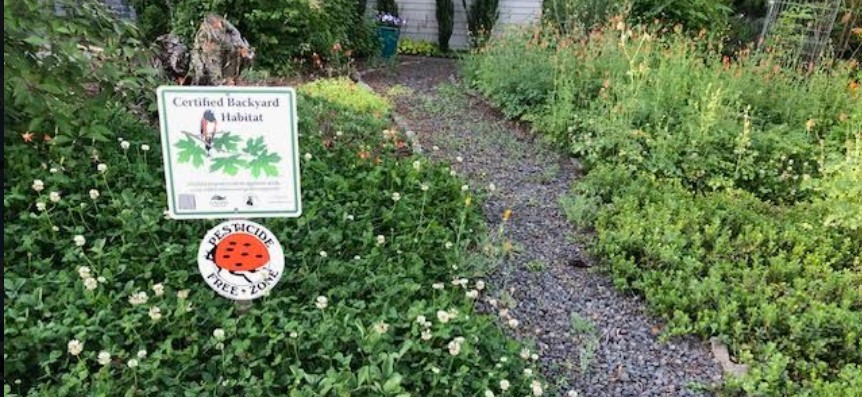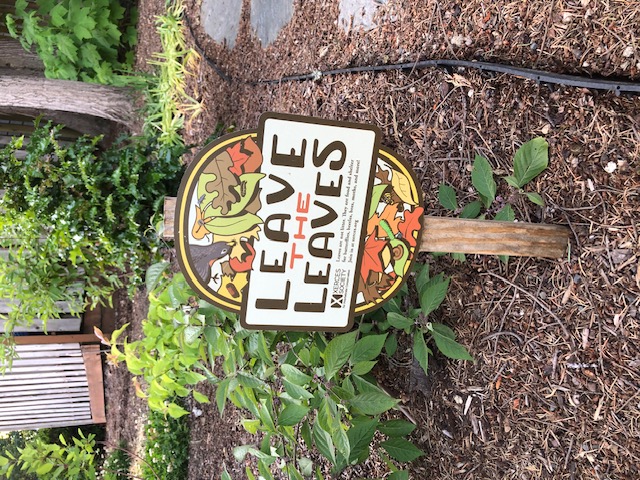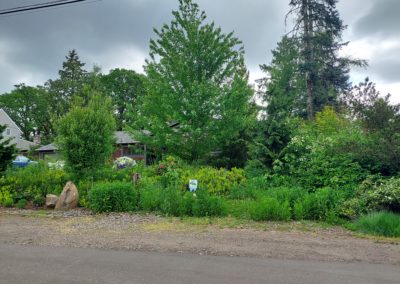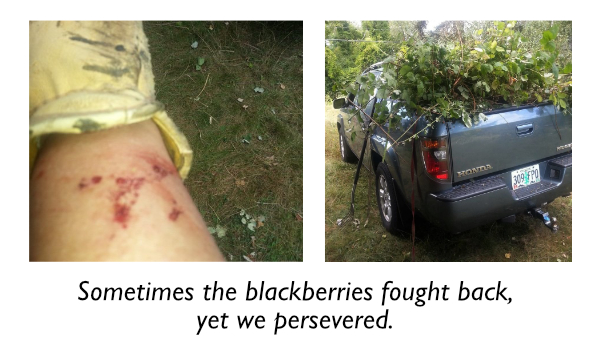Jul 21, 2025 | Electrify LO, Electrify LO Journey, Natural Resources - Testimonials

By Jim Newcomer, LOSN
I’m a subscriber to community solar power, so I warn you that I’m writing with a bias: I love it. But wait, there’s more: I’m part of an experiment that could increase our nation’s vegetable supply. What?
First, here’s my experience with the program. About two years ago my wife and I, who rent our home, wanted to access electricity that was procured from clean, renewable sources that would produce few greenhouse gas emissions – that is, not from coal or natural gas. Since we could not erect solar panels on our landlord’s roof, we signed up for Community Solar Power through the Oregon Community Solar Project.
At first we were disappointed – all their available solar farms were fully subscribed, and we were put on a waiting list. After a couple of months, though, a new project opened near us, and they accepted us as a subscriber. Immediately we began to receive electricity from it.
Nothing changed at our house. No new wires were connected; no adapters were required. We still got our power through those same PGE lines along our street, but PGE was receiving electrons from our solar farm and providing the equivalent flow of electrons to us from their power line. (Important concept – equivalent flow. It means we do not actually receive electrons from our solar farm into our home!)
We were informed that a company named Arcadia, a national firm that builds and manages solar farms in several states, had invested in our local solar farm and was managing our connection from there to PGE. We receive regular updates from them and we still, just as before, receive a monthly bill from PGE that oddly enough contains no mention of Arcadia or, for that matter, our connection to solar. We now receive normal electric service round the clock, of course, rain or shine, and we also experience all the power outages that occur to PGE customers. But I get a little rush of pleasure every time I think of our lights being powered by our solar farm!
I’ll add that in our experience the attraction of saving money on our monthly electric bill is virtually negligible – maybe $5 a month. Our satisfaction comes from knowing that despite renting our home, when we turn on the lights our energy comes directly from the sun instead of from a coal-fired generator or a natural gas turbine. We can say, just as if we had solar panels on our roof, most of our electricity is now clean and renewable.
Now here’s how we were surprised: Solar Harvest, the solar farm that produces our energy, is in a six-acre field not far from the airport in Aurora, down I-5 less than ten miles from our home. Then we discovered a second surprise: the Solar Harvest Farm near Aurora is operated by Oregon State University’s College of Agriculture as an experimental marriage of solar panels and farming.
There, under the rows of photovoltaic (PV) panels, they are planting shade-tolerant crops such as alfalfa, arugula, beets, bok choy, cabbage, carrots, chard, garlic, onions, parsley, radish, spinach, sweet potato, turnips and yams. To make it work, they have even enabled some of the solar panels to tilt up to allow tractors to pass.
Their purpose? To see if growing things under and among solar panels would increase production by cooling the ground in hot summer months and saving water. And it does! In their report evaluating the results from these last few summers, the authors come as close to waxing ecstatic as academic authors are allowed:
“Lettuce alone could justify a national project in agrivoltaics,” they report. “In 2012, U.S. farmers grew lettuce on 267,100 acres. PV panels on that land could generate 77 GW of electricity, more than the total U.S. installed capacity (60 GW) of PV power in 2018. Research by Prof. Chad Higgins, Solar Harvest Principal Investigator, shows that converting just 1% of the world’s agricultural land to agrivoltaics would offset global energy demand.”
Even more surprising, they have discovered an echo effect that boosts the benefits in the other direction as well: growing crops under PV panels cools the panels in return and thereby actually increases the efficiency of their solar production by some ten percent. It works both ways: PV panels increase vegetable production, and vegetable production increases electrical generation from the PV panels.
Just by signing up for free, in fact, saving $5 per month on our electricity bill, we get to be part of a grand, successful scientific experiment that will benefit people all over the world as well as slow climate change. What’s not to like?
As an obvious next step, Columbia Insight reported in 2023 that the OSU Extension Service is spreading this new idea among Oregon farmers: they don’t have to give up growing crops if they accept a solar farm on their land. In fact, they might even increase their yields in the fields when they erect photo-voltaic panels. The implications of that for agriculture are stunning.
All that information and satisfaction sprung from my family’s easy buy-in to a piece of a community solar project.
For more information, Electrify Now features short videos on its website about the advantages of signing up with community solar. And you can sign up there to connect. For even more detailed information, Electrify Now sponsored a free 45-minute webinar entitled “Community Solar – the Best-Kept Secret in Renewable Energy,” on July 17 featuring leaders of several of these community solar power organizations in a discussion of the state of community solar power today. The webinar recording is available here.
When you are ready you can join too, through any of these gateways: Oregon Clean Power Cooperative, Common Energy, or Electrify Now.
Jun 16, 2025 | Education, Natural Resources - Testimonials

Written by Jim Newcomer, LOSN Materials Management Team
On March 20, 2025, I was one of three members of our LOSN Materials Management Team that toured the EFI Materials Recovery Facility (MRF) on Swan Island. The MRF is where Republic Services, our trash hauler in Lake Oswego, takes the commingled recyclables that you put out on the curb weekly in your recycling can. For most of us, once Republic Services picks that can up and dumps it into their truck, it just disappears.
In the real world, Republic hauls the contents of our cans to the MRF on Swan Island, drives across the scale and sells by the pound to EFI Recycling, the company that runs the MRF. EFI separates the materials into separate streams of cardboard, paper, milk cartons, bottles, cans and so forth and, in turn, bales them and sells the separated materials to the companies that turn them into new products – paper and cardboard mills, metal foundries and forges, and plastics manufacturers.
While at the Swan Island facility, we watched a Republic truck drive over the scale and dump its load on the paved floor in the entry. EFI weighed the load, determined payment, then shoved the dumped mix into the hopper to begin the long, messy, complicated process of separating the contents. At the end of the process, they bale the separated materials and sell them to companies that recycle each material – i.e., OCC (Old Corrugated Cardboard) and paper products to pulp mills, tin cans to a steel manufacturer, and glass bottles to a glass recycler on North Columbia Blvd. I wasn’t going to pass up a chance to see that.
The Tour
We walked into the office and met Jeff Murray, marketing manager, who welcomed and briefed us on their operations – and cautioned us with safety tips – then gave each of us a hard hat and a safety vest. Only then could we set out into the yard.
It was a challenging tour on two counts. The physical part came first, as we climbed up ladders, crept along narrow catwalks and constantly ducked to avoid protruding motors and blocks. The second was understanding what we were seeing.
Consider the facility and its paved drive-in lot cover more than a city block with a loud, shaking, confusing array of conveyors, blowers, belts and bins two stories high. It includes sorters, both automatic and human, as well as moving conveyor belts, wheels with spaced holes, blowers to lift the plastic up and out, and walkways along picking lines where people stood plucking weird items out as fast as they could as the mix rushed by on a wide belt. It is all carefully designed, of course, and it follows a logical progression from removing the cardboard to the dumping roller at the end of the last belt that disposes of the material that didn’t belong in the mix, the waste.
The crisscrossing layers pile above one another in a noisy, fast-moving jumble of large machinery, so that as we climbed ladders, walked catwalks, descended steel stairs, and ducked under things, we were trying all the while to hear our guide over the din.
At the end of each process, each of the separated materials except the glass was bound up in six feet square bales – cardboard, cans, office paper, milk cartons, etc. – to be shipped off to their respective factories for remanufacturing.
EFI’s Business Model Reinforces Sustainability
It was a great experience, capped off by a conversation in the office in which Jeff explained their business model. EFI, he explained, buys from several haulers in the Portland region, including our Lake Oswego hauler, Republic, but it’s not a certainty. There’s competition from other MRFs to get their loads, so that they must pay top dollar for what they buy. In turn, they sell the separated materials to their customers, the recycling manufacturers, for competitive prices that depend on the shifting market prices for recycled materials as well as the amount of contamination in their streams; that is, how much trash remains in the separated material. EFI proudly claims that they sell the purest product in our region – on average less than 8% contamination in a load.
That means that of all the stuff you put in your mixed recyclables can, only 8% doesn’t get turned into new products.
One truth came through in all our conversations as well as from the process we observed: the utter dedication of EFI to recycling and sustainability. All the employees we talked with had come to EFI from other recycling companies or programs in schools and nonprofits. They are focused on producing clean, uncontaminated bales of materials that they can sell at good prices to companies that will reprocess them and get them back into circulation as remanufactured goods. Indeed, their livelihoods depend on it.
With corrugated cardboard cartons (called OCC) and the poly-coated milk and soup cartons produced by Tetra Pak, of course, producing a pure stream is relatively easy. The material has high value, is easy to separate and can be recycled over and over without weakening the fibers. The cardboard mills that take the OCC can also accept a certain amount of ordinary office paper in the mix they buy without ruining their end products. Office paper is a little more demanding, but still not too picky. Cans can be separated using magnets.
But plastic bottles? They’re demanding. Most of the bottles we can recycle are blow-molded, but even within that limitation there are variations and each must be steered into a separate stream. Designating each type means much more than reading a number in the chasing arrows. The way the container was produced, for example, blow molded or thermo-formed, determines the way it can be recycled – the temperature and the mixes in the product, for example. More complex, manufacturers tend to mix in special additives to give their plastic special qualities, and each additive makes a separate category as well. A small amount of incompatible material can spoil a whole shipment. So EFI strives to deal only with the blow-molded bottles that belong in the curbside mix. Most Important: they can’t afford not to produce quality material with low contamination.
One unexpected measure of EFI’s dedication to environmental values is their pride in a small item that a casual visitor would never spot but that they spent over a million dollars to dig: the bioswale along the street beside them. They dug it a few years ago along the low edge of their lot to catch and hold the run-off. It guarantees that the rainwater running off their paved lot goes into the ground rather than into a sewer, where it would end up polluting the nearby river.
Future Plans with the New Recycling Law
We plan to return to EFI in six or eight months to see what changes they have made as a result of funds they receive when the new Extended Recycling Act goes into effect in Oregon next month.
A Personal Note: Having served one year as Executive Director of the Washington State Recycling Association, I am especially interested in this operation and in the effects of the new law. It will require the plastic manufacturers to pay into a nonprofit that will use the funds to support recyclers as well as – I think, I hope – to take back a certain amount of their products for reuse. The payments from the plastics manufacturers should enable recyclers to invest in improvements in machinery and capacity.
When the new law begins to take effect next month (July 1), we all hope that ordinary residents like us will be offered the opportunity to recycle a gradually wider range of plastics in our curbside cans, and the manufacturers will be motivated to use a narrower range of materials in their plastic packaging. We’re looking forward to the day, and we’ll share what we learn as the New Law unfolds.




















 Oftentimes when we think about climate change we think of reducing our dependence on fossil fuels. Yet human contribution to the rise in carbon emissions in the atmosphere is not only due to our burning of fossil fuels, but also in the impoverishment of nature’s ability to absorb carbon in soil, in trees, and other high-carbon ecosystems. The degradation of our lands, including the earth’s fertile agricultural soils, is in itself another massive disaster facing humans. Yet, by looking to nature, we can take actions that can change this trajectory.
Oftentimes when we think about climate change we think of reducing our dependence on fossil fuels. Yet human contribution to the rise in carbon emissions in the atmosphere is not only due to our burning of fossil fuels, but also in the impoverishment of nature’s ability to absorb carbon in soil, in trees, and other high-carbon ecosystems. The degradation of our lands, including the earth’s fertile agricultural soils, is in itself another massive disaster facing humans. Yet, by looking to nature, we can take actions that can change this trajectory. 
 We love our trees! We love their shade, their graceful patterns against the sky and how they store carbon to combat climate change. But where would trees be without their roots? The roots we cannot see but know anchor the beauty towering over us. Where does that stability come from? The soil into which the trees reach. What do we know about that soil? Do we just take it for granted? It’s always there!
We love our trees! We love their shade, their graceful patterns against the sky and how they store carbon to combat climate change. But where would trees be without their roots? The roots we cannot see but know anchor the beauty towering over us. Where does that stability come from? The soil into which the trees reach. What do we know about that soil? Do we just take it for granted? It’s always there!

 Lake Oswego has a diverse urban forest and has been a member of Tree City USA for over 30 years! This means that individual trees throughout the city connect to create an urban forest system that provides countless benefits to the community. Do you love Lake Oswego’s trees and want to make a difference? OLWC is encouraging the community to celebrate Arbor Month 2021 by working together to preserve our urban forest.
Lake Oswego has a diverse urban forest and has been a member of Tree City USA for over 30 years! This means that individual trees throughout the city connect to create an urban forest system that provides countless benefits to the community. Do you love Lake Oswego’s trees and want to make a difference? OLWC is encouraging the community to celebrate Arbor Month 2021 by working together to preserve our urban forest. Date: Tuesday, March 16th, 2021
Date: Tuesday, March 16th, 2021 Councilor Mboup, who has lived in Oregon for over twenty years and in Lake Oswego since 2011, is the founder and Executive Director of the International Leadership Academy (ILA), a private, nonprofit French immersion school located in the heart of Lake Grove on Boones Ferry Road in the Hope Community Church.
Councilor Mboup, who has lived in Oregon for over twenty years and in Lake Oswego since 2011, is the founder and Executive Director of the International Leadership Academy (ILA), a private, nonprofit French immersion school located in the heart of Lake Grove on Boones Ferry Road in the Hope Community Church. Speaker: Kristin Ohlson, Author,
Speaker: Kristin Ohlson, Author,  Speaker: Dan Mabe, CEO, President of
Speaker: Dan Mabe, CEO, President of 